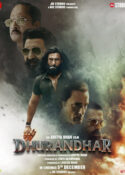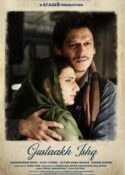 On the weekend I had the opportunity to watch one of the two new Diwali Releases, Sanjay Leela Bhansali’s SAAWARIYA. For those of you that do know me, I am a fine lover of the arts and off-beat style cinema – from my adventures at the Toronto Film Festival and other such movies.
On the weekend I had the opportunity to watch one of the two new Diwali Releases, Sanjay Leela Bhansali’s SAAWARIYA. For those of you that do know me, I am a fine lover of the arts and off-beat style cinema – from my adventures at the Toronto Film Festival and other such movies.
As such, while the other Indian film viewers preferred to watch and hoot about Shah Rukh Khan’s 6-pack in his latest saga OM SHANTI OM, I knew when I watched SAAWARIYA I would have a quality product on my hands. I didn’t believe a man that can make movies such as KHAMOSHI, DEVDAS and his most recent BLACK would falter with a script based on Fyodor Dostoevsky’s short story, “White Nights”.
SAAWARIYA is a film but more like a stage play, and as such – I would suggest, a viewer should approach the film as a theatrical production. The sets, the environment, and the overall cinematography are all setup a mini world – but the actors within them act like they are on a stage. Perhaps a parallel from Shirish Kunder’s JAAN-E-MANN can be drawn in this sense, which is a very innovative and different style of filmmaking in Indian Cinema which has not been utilized fully. Why am I saying this as such? Bhansali’s previous movie – BLACK- starring Rani Mukherji and Amitabh Bachchan – used its silences, the rhythms in each others voices – as the main musical soundtrack. And in the case of this movie, the viewer is literally bombarded with songs at even the slightest notice. (I digress: It does help each song is a beautiful creation of the environment, but it is as if Bhansali has created the songs himself, rather than appointed new Music Director Monty. Regardless however, the songs are a very strong part of the entire enterprise. More on this later…)
 Getting back to point – if it was another director at the helm of SAAWARIYA would one believe that they have utterly lost it. However, the bigger picture is that after creating BLACK or a KHAMOSHI, which can be considered art-house cinema, Bhansali perhaps put a little bit too much emphasis on the “intelligent” audience – because in a year filled with unintelligent and non-thinking films scaling new heights at the Indian Box Office – nobody would be in the mindset to actually “THINK”! Shame on Bhansali for remarking on the “THINKING” indian audience – for they’re all out in hiding, until Shahrukh’s obscenely mainstream “OM SHANTI OM” disappears, and audiences can start thinking again for themselves.
Getting back to point – if it was another director at the helm of SAAWARIYA would one believe that they have utterly lost it. However, the bigger picture is that after creating BLACK or a KHAMOSHI, which can be considered art-house cinema, Bhansali perhaps put a little bit too much emphasis on the “intelligent” audience – because in a year filled with unintelligent and non-thinking films scaling new heights at the Indian Box Office – nobody would be in the mindset to actually “THINK”! Shame on Bhansali for remarking on the “THINKING” indian audience – for they’re all out in hiding, until Shahrukh’s obscenely mainstream “OM SHANTI OM” disappears, and audiences can start thinking again for themselves.
It is a relief however to see the film is doing well. But perhaps overall it’s a fault of Bhansali’s to release his film on Diwali. Diwali releases were traditionally easy-thinking films, and Shahrukh (Producer and Star of Diwali’s other release – OM SHANTI OM) took advantage of this, and released his film, much after Bhansali set his date. However, Bhansali will get over this setback.
It is my intention to point out, however, that Bhansali uses theatrical styles of filmmaking and to showcase his environment and his two new stars (Ranbir Kapoor – Grandson of Raj Kapoor, son of Rishi Kapoor – and Sonam Kapoor, daughter of Anil Kapoor). So even though from our perspective it looks like Bhansali has gone mad, throwing songs in at the drop of a hat – it is more of Bhansali’s point to showcase that this is a stage theatrical production – at least in my own perspective. The dances even showcase this extravagance, such as the grand “Eid” song that Ranbir sings at the mosque while Sonam looks at the sky to see the moon, or the dance performed by Rani and the other Prostitutes around the town towards Ranbir, who is hurting. And may I not forget the title song, which introduces Ranbir and is the theme of the entire film. The way each of these songs take place is opulent in nature, and extremely theatrical.
 Another point to consider in this angle is the blue-green feel of the film, with light coming in at various instances in the film – showcasing a metaphor of “darkness” versus “light” – another point to take in consideration of the filmmaking style of Bhansali. Even Black showcased the lighting and “snow” in such a way that allowed for viewers to understand the message of the filmmaker through these scenes.
Another point to consider in this angle is the blue-green feel of the film, with light coming in at various instances in the film – showcasing a metaphor of “darkness” versus “light” – another point to take in consideration of the filmmaking style of Bhansali. Even Black showcased the lighting and “snow” in such a way that allowed for viewers to understand the message of the filmmaker through these scenes.
As introduced at the beginning of the production by Rani Mukherji, this film takes place in an environment which cannot be placed on a map, nor having been understood as any one time era. One could argue that one doesn’t know “where” this place happens, or “when” does it happen – but to be frank, such comparisons are trivial, and almost child-like in nature – given the bigger picture that the film is a stage production.
For one with knowledge of the older ages of Indian Cinema – viewers will remember Raj Kapoor standing underneath an umbrella with Nargis from Shree 420. Perhaps the following picture, which has become part of Indian Cinema history, will re-jog some memories – upon taking consideration of the poster at the beginning of this post.
So what really is SAAWARIYA? Is it a film about Innocence in love? Is it a film about Ranbir Kapoor receiving a legendary launch, with many characteristics of his being recognized as part of Raj Kapoor’s persona in previous films? Is it Bhansali trying to tip his hat to the Kapoors and their contributions to the industry? Is it Bhansali trying to put too much into one production? Yes, its all of these.
 Bhansali’s faltering, in my eyes, with this film is trying to bring together too much at one time. While Ranbir does have the energy, acting skill and charisma that will make him a legend of indian cinema – and his character showcases all of that. carrying the film entirely on his shoulders – it is not a film that Mainstream audiences will be able to digest quickly.
Bhansali’s faltering, in my eyes, with this film is trying to bring together too much at one time. While Ranbir does have the energy, acting skill and charisma that will make him a legend of indian cinema – and his character showcases all of that. carrying the film entirely on his shoulders – it is not a film that Mainstream audiences will be able to digest quickly.
In fact – it took me time to look at the film and put everything together before writing this critique. One can tell Bhansali wants a viewer that can look deeper than just what’s on the surface. The fact that audiences were remarking “what’s with all the darkness”, “why so much blue”, “too many songs” or “Why, oh why, is the ending with Sonam the way it is?” just shows me that the audience was introduced to too much, too quickly – and required to THINK too much. Plus, a pre-requisite of the film could be that one has to understand a bit of the past of Indian Cinema. Perhaps I can understand what exactly this film is about because there’s an appeal in this film that I didn’t want to let go of – and refused to until I understood exactly what Bhansali was trying to accomplish here.
And now that I have – I’ve come to the realization that this film is completely different from all of SLB’s previous works. It is of international standards, but really does reach a very select group of viewers. To Bhansali’s credit, he has got enough of a mainstream approach to the film. As with Kunder’s JAAN-E-MANN, the songs of this film are a highlight, and can very much appeal to the mainstream viewer. But not with a Shahrukh Khan film releasing opposite of it. The best of the bunch are the title song “Saawariya….Saawariya…”, the Eid song “Yoon Shabnami”, “Pari” which takes place on the streets, and “Jaan-E-Jaan” – the tribute song to Raj Kapoor and his style of cinema.
I don’t expect a lot of people to agree with this next statement, but I will offer it in any case – Bhansali’s film is more likely than ANY of his other films – to do well on an international standard, such as at the Oscars. He has taken his filmmaking to the next level, which many people will not understand, but for the folks that will understand – it is a gallant effort, and has achieved his cinematic crescendo.
The best part of the enterprise? Besides Bhansali’s direction and the environment created, it is Ranbir Kapoor’s performance. As stated earlier, his acting ability astounds the viewer – with his energy, charisma and overall appeal. SAAWARIYA is his performance, as he carries the film on his shoulders – and carries the hearts of every viewer with him. And yes, the final scene in the movie is a very happy and satisfying one, but only for the folks that can understand the film again.
I will not remark on Sonam Kapoor’s debut for a few reasons – first, she is in every scene that Ranbir is in, and he steals each and every scene with his performance. Secondly, I don’t believe we have seen her true acting ability. I feel she can do much, much more – than what was given to her in this movie. I would attribute her role to bad writing.
 Rani Mukherji adds another trump to her already brilliant film resume, as the narrator and Rulab, the prostitute. I have heard many people remarking “why, in her last scene in the movie, turn against Ranbir?” Think – the movie asked the same question, and if you actually think about the answer, you will see why. It’s helped him on his journey towards becoming WHO he is.
Rani Mukherji adds another trump to her already brilliant film resume, as the narrator and Rulab, the prostitute. I have heard many people remarking “why, in her last scene in the movie, turn against Ranbir?” Think – the movie asked the same question, and if you actually think about the answer, you will see why. It’s helped him on his journey towards becoming WHO he is.
Salman Khan is not only a terrible actor but also in need of a very, very long sleep. In every scene of the movie he is a part of – everyone is on the edge of their seat – to see if he will close his eyes and start snoring. He has also aged considerably, and does not look the part at all.
In conclusion, SAAWARIYA is a good film that perhaps tries to do too much – without giving viewers a chance to really understand what’s going on. A pre-requisite of this film, to truly appreciate it, should be to understand Indian Cinema’s past, especially it’s first family, the Kapoors – and the types of films its family has been a part of. The film, thankfully enough, has recovered its investment and is on its way to a hit. And perhaps it is a good thing that audiences continue to watch the film – perhaps establishing that the audience is thinking. However, based on Indian Film Critics and their bias towards mainstream cinema – this film is an excellent film. And Bhansali has cemented his status, in my mind, as a director who makes meaningful films and presents them as such.
Rating: 4/5








